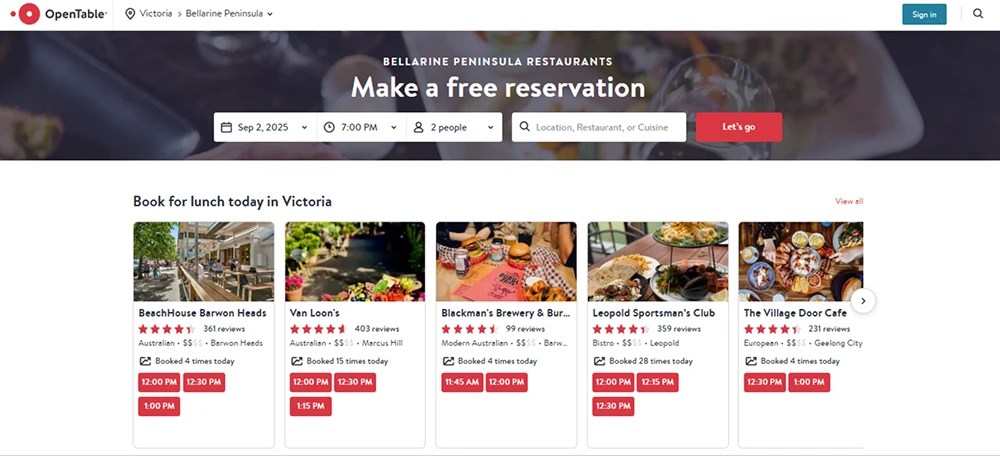OpenTable(Restaurants) Overview & 2025 Industry Position
With dining habits continuing to shift and customer experience becoming a competitive differentiator, OpenTable(Restaurants) stands positioned as a cornerstone reservation and table management solution for hospitality venues in 2025. Founded with the goal of modernizing restaurant reservations, OpenTable has expanded to offer a comprehensive suite of diner relationship tools ranging from bookings and waitlisting to CRM, guest feedback loops, and back-of-house operations.
Now part of global travel platform Booking Holdings, OpenTable(Restaurants) rides the momentum of its vast diner network—over 1 billion seated guests annually—and data insights to help restaurants of all sizes remain agile and bookable in a post-pandemic era where digital-first experiences dominate.
From Launch to 2025: OpenTable(Restaurants)’s Journey
Founded in 1998 in San Francisco, OpenTable began as a basic reservation tool for diners to book tables online. By 2014, it was acquired by Booking Holdings and began rapidly expanding features and international coverage. Key milestones in its journey include:
- 2008: Launched Electronic Reservation Book (ERB), digitizing front-of-house operations.
- 2015: Introduced guest insights and diner management tools.
- 2020: Rolled out contactless dining and QR-code menus amid the COVID-19 pandemic.
- 2023: Launched AI waitlist and real-time table availability mapping.
- 2025: Expanded integration partnerships with POS, CRM, and loyalty platforms with a unified API dashboard.
The 2025 strategy centers on positioning OpenTable(Restaurants) as not just a bookings tool, but as an intelligent guest experience platform with actionable insights, omnichannel integrations, and real-time operational visibility.

OpenTable(Restaurants) Key Features
The 2025 OpenTable(Restaurants) dashboard is built as a central command center for modern restaurants and hospitality venues. Key features include:
- Table Management: Real-time availability, floor visualization, customizable seating grids.
- Reservations Engine: Online bookings directly via OpenTable app, website widgets, Google/Bing integrations.
- Waitlist & Walk-ins: AI-powered estimated wait times, SMS updates, no-app guest check-ins.
- Guest CRM: Tracks profiles, dining histories, preferences, and notes for personalization.
- Feedback Tools: Automated diner surveys, reputation monitoring, and guest sentiment analytics.
- Shift & Staff Planning: Sync reservations with staffing needs and optimize FOH efficiency.
Workflow & UX
Usability is a top priority in the OpenTable(Restaurants) 2025 ecosystem. The platform offers intuitive navigation, clear visual hierarchy, and color-coded table states, ensuring hosts can manage dining traffic at a glance. Guest and reservation functions are easily accessible across mobile, browser, and iPad interfaces. The quick-access tabs make it simple to jump between floors, profiles, reporting, and messaging without interrupting service flow.
Pro Tip: Use table state color coding and auto-notifications to reduce manual host communication during peak dining hours.
OpenTable(Restaurants) Pricing Analysis & Value Metrics
As of July 2025, OpenTable(Restaurants) offers flexible pricing based on the restaurant’s monthly booking volume and required features. Below is a quick comparison of current plans:
| Plan | Monthly Price | Booking Fee | Core Features Included |
|---|---|---|---|
| Basic | $39/mo | $1 per cover | Online booking widget, POS sync |
| Core | $129/mo | $0.50 per cover | Full reservation tools, guest CRM, waitlist |
| Premium | $499/mo | $0.25 per cover | Marketing, reporting, integrations, VIP tools |
The Premium plan adds high-value integrations and insights for medium-large venues looking to optimize diner occupancy rates and upsell opportunities. Smaller venues can still extract solid ROI from the Core tier by utilizing its guest and messaging tools.
Competitive Landscape
In 2025, OpenTable(Restaurants) competes most closely with:
- Yelp Guest Manager: Strong in North America, especially with smaller restaurants; ties into Yelp ecosystem.
- Resy: Trend-forward presence in high-end urban markets; sharp UX and exclusivity branding.
- Tock: Prepaid and timed dining focus; ideal for fine-dining and tasting-menu operations.
Each has strengths, but OpenTable(Restaurants) continues to win on diner volume, booking distribution breadth, and CRM depth.
Use Cases Where It Shines
OpenTable(Restaurants) is best suited for:
- Full-service restaurants with 25+ seats
- Multi-location hospitality groups managing guest preferences
- Winery tasting rooms and chef-tasting menus
- Hotel restaurants needing booking integration with PMS systems
It’s less ideal for walk-up-centric, fast-casual eateries with low tech dependence or limited online visibility goals.
Pros & Cons
- Pros:
- Massive diner network and direct integrations with platforms like Google and Instagram
- Robust CRM tools for personalized hospitality
- Multi-location management with consistent UI
- Forecasting and reporting dashboard by shift and daypart
- Cons:
- Per-cover fees can add up for high-volume venues
- Learning curve for full feature set
- Limited offline reservation access during internet outages
Integrations & Ecosystem
In 2025, OpenTable(Restaurants) boasts over 100 official integrations via its API connectors. Notable ones include:
- Point of Sale: Square, Toast, Lightspeed
- CRM & Loyalty: SevenRooms, Punchh, Thanx
- Analytics: Google Analytics 4, Looker Studio
- Marketing: Mailchimp, Meta, Constant Contact
Its open ecosystem allows restaurants to layer preferred solutions around OpenTable(Restaurants)’ powerful booking rail foundation.
Final Thoughts
OpenTable(Restaurants) continues to evolve beyond its booking roots, offering a restaurant-first platform that supports modern hospitality through smart reservations, insights, and experiences guests remember. While not suited for counter-serve operations, it remains a top-tier reservation and diner intelligence system for venues focused on experience as a driver of revenue and retention.
OpenTable(Restaurants) FAQ
Yes, OpenTable(Restaurants) integrates with major POS systems like Toast, Square, and Lightspeed to streamline service and sync cover data.
Premium includes advanced reporting, marketing tools, integrations, and reduced cover fees—designed for larger or multi-unit establishments.
Yes, OpenTable(Restaurants) typically offers a 30-day free trial which includes access to the Core plan features for evaluation.
Absolutely. OpenTable(Restaurants) enables two-way SMS notifications for both confirmations and waitlist updates.
Yes. With the website widget, restaurants can tailor branding, timing, and availability within their site to match operational style.